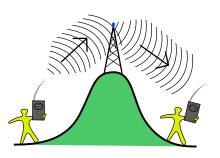Repeater
This article needs additional citations for verification. (August 2007) |

A repeater is an electronic device that receives a signal and retransmits it at a higher level or higher power, or onto the other side of an obstruction, so that the signal can cover longer distances.
History
Before the invention of electronic amplifiers, mechanically coupled carbon microphones were used as amplifiers in telephone repeaters. The invention of the audion tube made transcontinental telephony practical. In the 1930s vacuum tube repeaters using hybrid coils became commonplace, allowing the use of thinner wires. In the 1950s negative impedance gain devices were more popular, and a transistorized version called the E6 repeater was the final major type used in the Bell System before the low cost of digital transmission made all voiceband repeaters obsolete. Frequency frogging repeaters were commonplace in frequency-division multiplexing systems from the middle to late 20th century.
Description
The term "repeater" originated with telegraphy and referred to an electromechanical device used by the army to regenerate telegraph signals.[citation needed] Use of the term has continued in telephony and data communications.
In telecommunication, the term repeater has the following standardized meanings:
- An analog device that amplifies an input signal regardless of its nature (analog or digital).
- A digital device that amplifies, reshapes, retimes, or performs a combination of any of these functions on a digital input signal for retransmission.[1]
Because repeaters work with the actual physical signal, and do not attempt to interpret the data being transmitted, they operate on the Physical layer, the first layer of the OSI model.
Usage
Repeaters are used to boost signals in coaxial and twisted pair cable and in fiber optics. A network hub is one such device.
An optical communications repeater is a piece of equipment that receives an optical signal, converts that signal into an electrical one, regenerates it, and then retransmits an optical signal. In contrast, Optical amplifiers are often used in transcontinental and submarine communications cables, because the signal loss over such distances would be unacceptable without them.
Radio repeaters are used in radio communication services. Radio repeaters are also used extensively in broadcasting, where they are known as broadcast relay stations.
A digipeater is a blend meaning "digital repeater", particularly used in amateur radio. Store and forward digipeaters generally receive a packet radio transmission and then retransmit it on the same frequency.
When providing a point-to-point telecom link using radio beyond line of sight, one uses repeaters in a microwave radio relay. A reflector, often on a mountaintop, that relays such signals around an obstacle, is called a passive repeater.
See also
- 12-channel carrier system
- ADSL loop extender
- Cellular repeater
- Complementary ground component
- Fiber media converter
- PLC carrier repeating station
- Repeater insertion in integrated circuits
- Signal strength
- Transponder
- Wireless Distribution System
References
- ^
 This article incorporates public domain material from Federal Standard 1037C. General Services Administration. Archived from the original on 2022-01-22. (in support of MIL-STD-188).
This article incorporates public domain material from Federal Standard 1037C. General Services Administration. Archived from the original on 2022-01-22. (in support of MIL-STD-188).
External links
- Repeater Electrical Engineer Standard Dictionary
